Computing at CERN
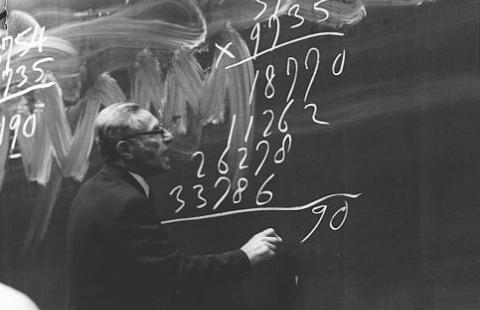
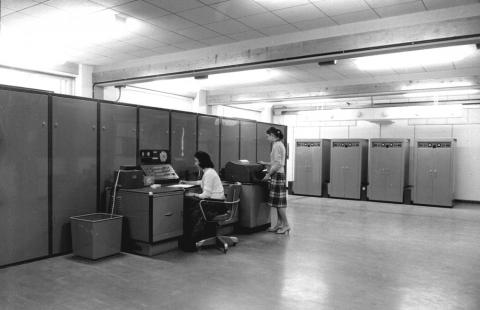
CERN installs its first electronic computer: The Ferranti Mercury
CERN's first computer, a huge vacuum-tube…
Know more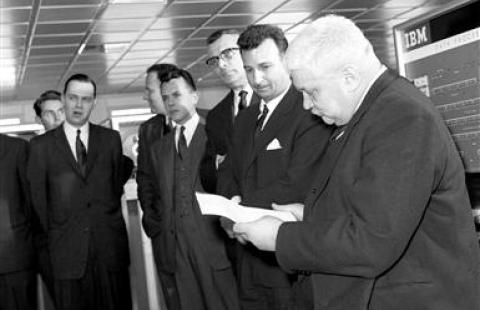
Just add "0": The IBM 7090 replaces the IBM 709
The IBM 7090 was installed at CERN in 1963.…
Know more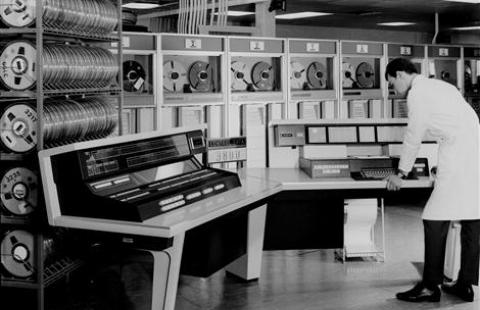
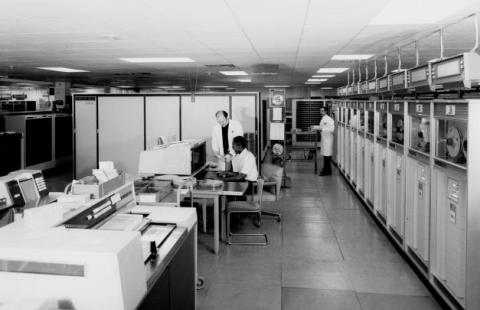
The Finance Committee approves the purchase of a CDC 6400
At its 81st meeting on 16 February 1967, CERN's…
Know moreThe Canton of Geneva acquires the CDC 3800 for the University of Geneva
The Canton of Geneva bought the CDC 3800 from…
Know more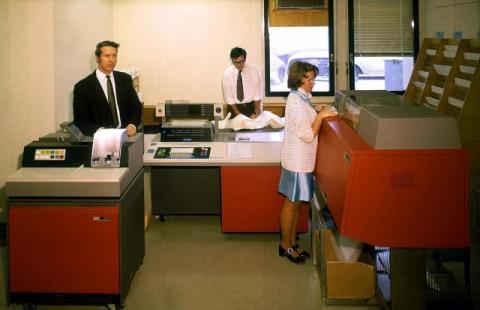
The Computer Centre handles 15,000 to 20,000 jobs per week
A Data Handling Division report by Philipe Bloch…
Know more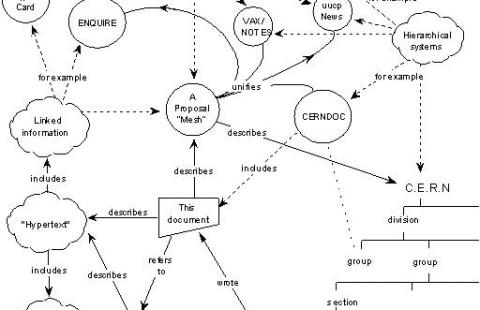
Sir Tim Berners-Lee submitted his first proposal for what became the World Wide Web
In March 1989, Sir Tim Berners-Lee, while working…
Know more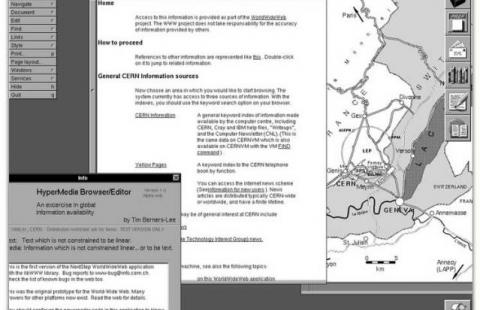
The world's first browser/editor, website and server go live at CERN
By Christmas 1990, Sir Berners-Lee had defined…
Know moreCERN signs contract for a remote data centre in Budapest
CERN today signed a contract with the Wigner…
Know more
Embed this timeline
Wim Klein, CERN's first computer
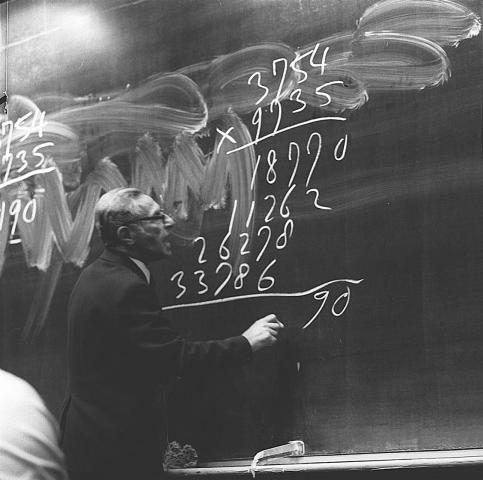
Before electronic computers were available at CERN, a Dutchman called Willem "Wim" Klein performed astonishing feats of mental arithmetic to help his colleagues with their calculations.
Klein was born in Amsterdam in the Netherlands on 4 December 1912. He first displayed his mathematical talents in circuses around Europe. He joined CERN's Theory Division in 1958, where he was in considerable demand as a calculator in the days before the first electronic computers.
On 27 August 1976, Klein calculated the 73rd root of a 500-digit number in 2 minutes and 43 seconds, a feat recorded by the Guinness Book of Records. He became known as "the human computer".
Klein was found dead in his home in Amsterdam on 1 August 1986. He had been stabbed to death. The killer was never identified.
Find out more:
Reader's Digest, 1976. "Meet the human computer"
Video: "Wim Klein demonstrating his arithmetical prowess at CERN, in 1976"
CERN installs its first electronic computer: The Ferranti Mercury
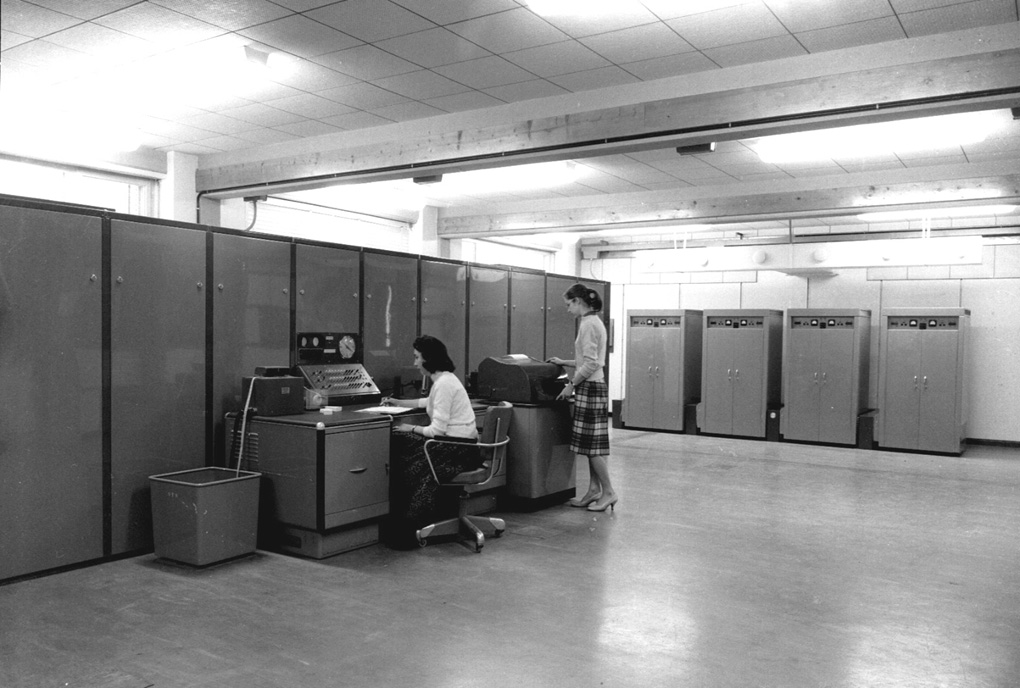
CERN's first computer, a huge vacuum-tube Ferranti Mercury, was installed in 1958. It was one million times slower than today's large computers. Though the Mercury took 3 months to install – and filled a huge room – its computational ability didn't quite match that of a modern pocket calculator. "Mass" storage was provided by four magnetic drums each holding 32K × 20 bits – not enough to hold the data from a single proton-proton collision in the Large Hadron Collider. The Mercury ran a simplified coding system called Autocode – a type of programming language with a limited repertoire of variables.
At the end of its career the Mercury was connected online to the Missing Mass Spectrometer experiment. In 1966 it was shipped to Poland as a gift to the Academy of Mining and Metallurgy at Cracow. Although it was quickly taken over by transistor-equipped machines, a small part of the Mercury remains in the CERN IT department. The computer's engineers installed a warning bell to signal computing errors – the bell is mounted on the wall in a corridor of building 2.
See video: "Computing at CERN in 1965" (features the Ferranti Mercury)
Technical specifications
FERRANTI Mercury
Ran at CERN from 1958 to 1965
First generation vacuum tube machine
60-microsecond clock cycle, 2 cycles to load or store, 3 cycles to add and 5 cycles to multiply 40-bit longwords
No hardware division
Magnetic core storage (1024 40-bit words, 120-microsecond access time)
Processor with floating-point arithmetic and a B-Register (an index register)
Magnetic-drum auxiliary storage (16 Kwords of 40 bits, 8.75 msec average latency, 64 longwords transferred per revolution)
Paper tape I/0
Two Ampex magnetic-tape units added in 1962
Autocode compiler
CERN inaugurates the IBM 709
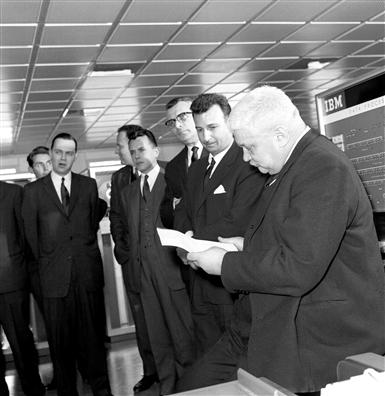
The IBM 709 arrived at CERN toward the end of 1960. It was inaugurated at an official ceremony on 6 March that year, where computer engineer Lew Kowarski delivered a speech (see image).
With Mercury and the 709 operating together, CERN had its first experience of compatibility problems. This was a continuing source of difficulty as various different computers came into operation at CERN. Many of CERN's programs were also used on a range of computers in its 13 member states.
A high-level computer-programming language called "FORTRAN" (short for "FORmula TRANSlating")that made its CERN debut with the 709, and this language quickly became the only programming language in general use at the laboratory. A new generation of programs, written in FORTRAN to exploit the greater speed of the IBM 709, were brought in to analyse measurements from bubble-chamber photographs.
The IBM 709 was a vacuum-tube machine with a core memory size of 32K 36-bit words. The central processing unit (CPU) was 4-5 times faster than that of the Mercury, but compiling a typical FORTRAN program could still take several minutes. Tape bins made way for card trays. As many as six peripheral devices could be attached via their controllers to data channels on the 709, to access core memory buffers while the CPU performed other work. The Direct Data Connection – an innovation of the machine – allowed for direct transmission of data from external equipment to memory via a channel. The speed was in principle up to 1 megabit per second.
After one year of experience, CERN added a small IBM 1401 to speed up the input/output, job sequencing and operations. The concept of SPOOLing (Simultaneous Peripheral Operation On-Line) with its 1/0 files (virtual reader/printer) has its origins in the days of 709 operations.
Technical specifications
IBM 709
Ran at CERN from 1961 to 1963
Vacuum-tube machine
12-microsecond clock cycle, 2 cycles to add and 15 on average to multiply 36-bit integers
Hardwired division and floating-point arithmetic, index registers
Core storage: 32K words of 36 bits, 24-microsecond access time
Card reader (250 cards per minute) and card punch (100 cards per minute)
Line printer
Magnetic-tape units (7 tracks, 75 inches written per second at 200 bytes per inch)
Introduction of the Data Channel
FORTRAN compiler
FORTRAN monitor system
Just add "0": The IBM 7090 replaces the IBM 709
The IBM 7090 was installed at CERN in 1963. It was about four times more powerful than the 709. The computer was connected to a device call a Hough-Powell digitizer (HPD) – a machine that scanned films from bubble chambers, measured important tracks, and sent the information directly to the 7090. A second device, "Luciole", was also connected to the computer, providing fully automatic measurements from spark-bubble chambers. Over 300,000 frames of spark-chamber film were automatically scanned and measured in this way, beginning the trend towards online use of computers for processing experimental data.
Technical specifications
IBM 7090
Ran at CERN 1963 to 1965
Transistorized second-generation machine with a 2.18-microsecond clock cycle
Core storage: 32K words of 36 bits, 4.36-microsecond access time
Card 1/0, Tape units wrote on 7 tracks at 112.5 inches per second, 200 to 556 bytes per inch
8 data channels
Interrupt system
FORTRAN compiler
Basic monitor operating system (IBSYS)
Connected online to flying-spot digitizers (HPD and Luciole) to measure bubble and spark chamber films
The CDC 6600 arrives at CERN
The CDC 6600, made by the Control Data Corporation, arrived at CERN on 14 January 1965. It was the first multi-programmed machine in the CERN Computer Centre, with about 10 times the processing capacity of the IBM 7090.
The 6600 was used to analyse the 2-3 million photographs of bubble-chamber tracks that CERN experiments were producing every year. Human operators recorded significant observations from frames of bubble-chamber film onto punched cards. A machine called a Hough-Powell digitizer (HPD) scanned the cards and sent the information to the 6600. A device called YEP also measured significant tracks on bubble-chamber photographs, coded them onto paper tape, and sent this information to the computer. A third device – "Luciole" – provided the 6600 with fully automated measurements of spark-chamber film.
The CDC 6600 filled a large room. It consisted of 12 data channels, 10 peripheral processors, a central magentic-core memory and a central processor. Devices such as the HPD were connected directly to the computer by data channels. The 6600 was also connected to card readers that ran about 500 FORTRAN problems per day, and to two online computers – the SDS920 and the IBM 1800 – via CERN-made data links. The results of calculations on the 6600 were printed on paper or punched onto cards for further study.
The change-over from the IBM 7090 was planned to take 3 months starting in January 1965. Major engineering overhauls were needed during the first few years, which led to a 2-month shut-down in 1968 to modify the 6600: CERN's pre-production model needed to incorporate the logic and packaging improvements that had been introduced in CDC's production machines. During this period of struggling with hardware instability and software development, computing work at CERN was done partly by sending jobs to outside computers and partly by processing data on a CDC 3400, and later on a 3800, temporarily made available by the Control Data Corporation.
Find out more
Video: The Control Data 6600 arrives at CERN
For a more technical account, see "35 years ago – the Control Data 6600"
Technical specifications
CDC 6600, serial number 3 (pre-production series machine)
Ran at CERN from 1965 to 1975
Transistor machine
Central Processing Unit clock cycle: 100 nanoseconds
Core memory: 128K words of 60 bits (converted to modern terms, with 8-bit bytes, this is 0.94 MB)
Memory access: 1 microsecond (but independent memory banks allowed for up to one access per clock cycle)
Instruction prefetch function
Ten overlapping functional units
Ten autonomous peripheral processor units (PPU's) each with 4K 12-bit words of core memory
Huge disks over 1 metre in diameter held 500 million bits each
Tape units (half inch tape: 7 tracks, recording 200, 556 and 800 bytes per inch; one-inch tape: 14 tracks recording 800 bytes per inch)
High-speed card reader (1200 cards per minute)
The CDC 3800 boots up temporarily
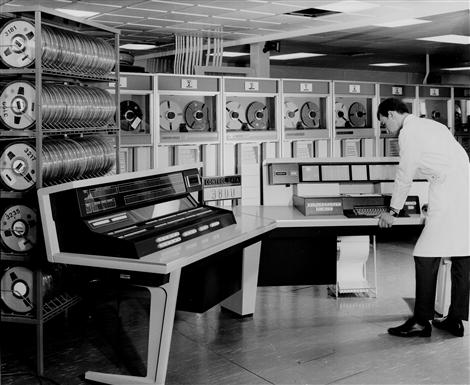
The 3800 was a member of the 3000 series Control Data Corporation family of computers, incompatible with the 6000 series machines. The 3800 had a 48-bit architecture. Its 64 Kword core memory was replaced by a faster, 800-nanosecond memory during its stay at CERN. This machine was eventually acquired by the State of Geneva and installed at the local University of Geneva. At CERN it was replaced by a CDC 6400. It is worth noting that CERN acquired other machines of the 3000 series, such as a 3100 for the FOCUS project offering semi-interactive facilities and quick sampling of experimental data at the central computers, and a 3200 for interactive graphics applications.
The Finance Committee approves the purchase of a CDC 6400
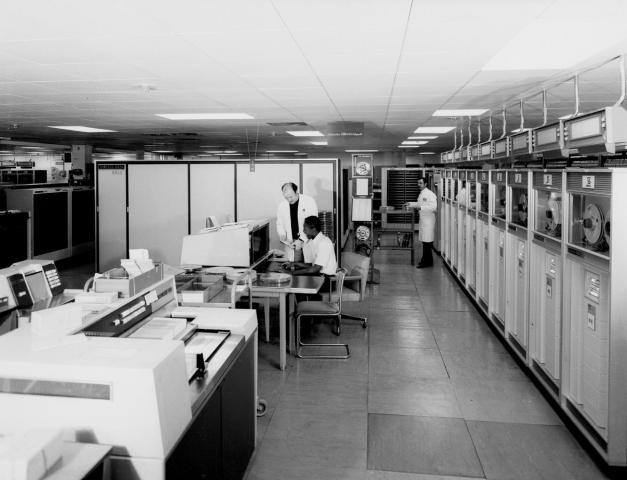
At its 81st meeting on 16 February 1967, CERN's Finance Committee authorized the purchase of the CDC 6400 computer, a small CDC 3100, and four magnetic tape units. The costs exceeded the funds available in the 1967 budget by 7-8 million Swiss francs. In its next meeting the Committee recommended the use of CERN's own funds for the purchase, "only raising a bank overdraft if this is necessary to cover the cash requirements".
The CDC 6400 was installed at CERN later that year.
The Canton of Geneva acquires the CDC 3800 for the University of Geneva
The Canton of Geneva bought the CDC 3800 from CERN, and installed it at the University of Geneva. At CERN, the CDC 3800 was replaced by a CDC 6400.
The 6400 is upgraded to a 6500
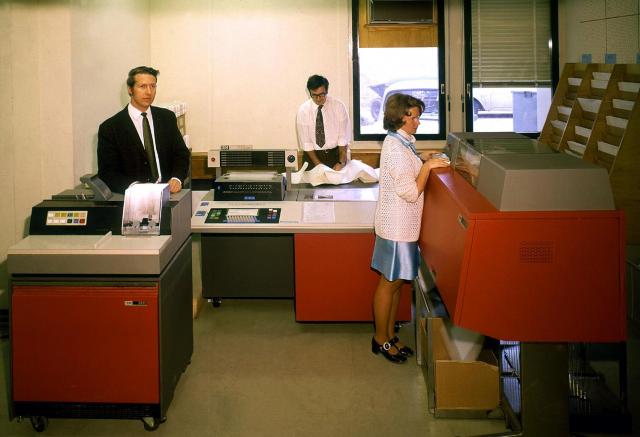
The CDC 6400 was upgraded to a CDC 6500 in 1969. This image, taken on 12 February 1974, shows a general view of the remote input/output station installed in building 112, used for submitting jobs to the CDC 6500 and 6600. The card reader on the left and the line printer on the right are operated by programmers on a self-service basis.
The Computer Centre handles 15,000 to 20,000 jobs per week
A Data Handling Division report by Philipe Bloch states:
Around the CERN sites more than 150 computers of widely varying sizes are installed. They vary from small mini-computers (PDP8, HP2115A) via larger mini's and control computers (PDP11/45, HP4100, Nord-10, IBM1800, Modular One, Ferranti Argus 500) over medium sized computers such as PDP-10, IBM-360/44, CII 10070 and CDC 3200 to very large computers (CDC 6600, CDC 7600) in the Computer Centre itself. Many mini-computers are used by experimenters for data collection but accelerator control, remote batch stations and process control application use most of these. The medium sized computers are normally dedicated to particular types of processing for individual groups or divisions: measurements of bubble chamber pictures (CDC 3200, ERASME on the PDP-10), support for data collection for the OMEGA spectrometer and the Split Field Magent (CII 10070).
The Computer Centre is part of the Data Handling Division and provides a general purpose scientific computing service to both Laboratories... About 700-800 different users run approximately 15,000-20,000 jobs per week on the main computers and mount about 4000 tape reels from a total tape library of more than 6000 reels. Remote batch and terminal services as well as high-speed data links and a delivery service make computing easily accessible practically everywhere on the site round the clock.
Sir Tim Berners-Lee submitted his first proposal for what became the World Wide Web
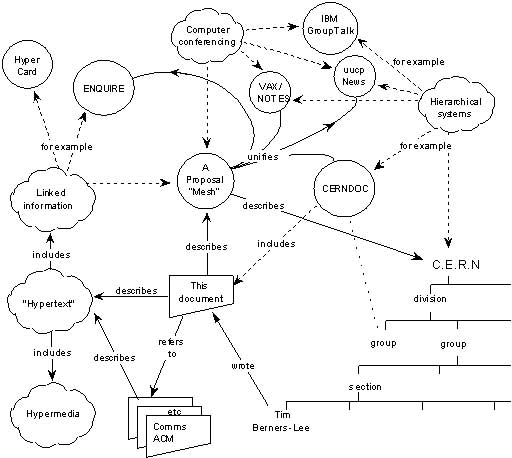
In March 1989, Sir Tim Berners-Lee, while working at CERN, wrote a proposal to develop a distributed information system. He resubmitted a slightly edited version in May 1990.
The world's first browser/editor, website and server go live at CERN
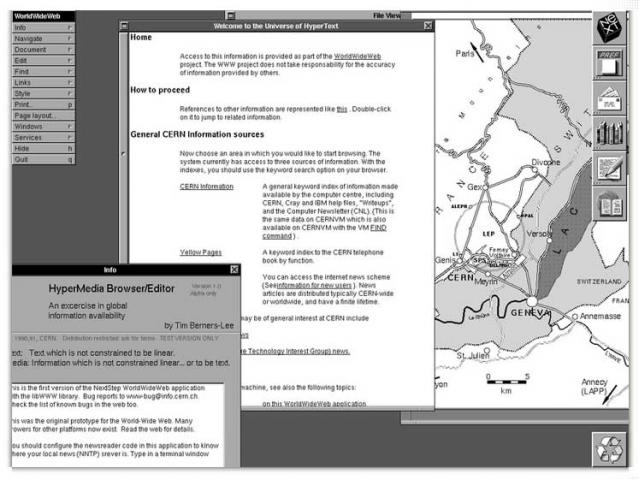
By Christmas 1990, Sir Berners-Lee had defined the Web’s basic concepts, the html, http and URL, and he had written the first browser/editor and server software. info.cern.ch was the address of the world's first web server, running on a NeXT computer at CERN. The world's first web page address provided information about the World Wide Web project.
LHC Computing Grid phase 1 launched
The following is an extract from: "The LHC computing grid project at CERN" (Lamanna, 2004)
The first service of the LHC Computing Grid, called LCG-1 was opened on September 15th, 2003, with 25 sites worldwide. In this phase, the goal was to allow the experiments to try out the system and test their software on it. Although incomplete in functionality, in particular, due to some limitation in the data management interface to tertiary storage, LCG-1 is demonstrating very good stability and serving as a basis for the users to prepare for the 2004 data challenges.
EU DataGrid project passes final review
The aim of the European Datagrid project was to produce a "production quality" computing Grid, in anticipation of the construction of the Worldwide LHC Computing Grid. According to the project's website:
The objective is to build the next generation computing infrastructure providing intensive computation and analysis of shared large-scale databases, from hundreds of terabytes to petabytes, across widely distributed scientific communities
The project passed its third and final review at CERN on 19 February 2004.
CERN signs contract for a remote data centre in Budapest
CERN today signed a contract with the Wigner Research Centre for Physics in Budapest for an extension to the CERN data centre. Under the new agreement, the Wigner Centre will host CERN equipment that will substantially extend the capabilities of the LHC Computing Grid Tier-0 activities. This contract is initially until 31 December 2015, with the possibility of up to four one-year extensions thereafter.
“Installing computing capacity at the Wigner Centre allows us to power additional equipment as well as secure our operations due to the remote nature of the resources” said Frédéric Hemmer, Head of CERN’s IT Department. “For example, should we suffer a prolonged power cut at CERN, we will be able to transfer critical functions to the Wigner Centre, mitigating the risk of having all of Tier-0 in one location."
Read the press release